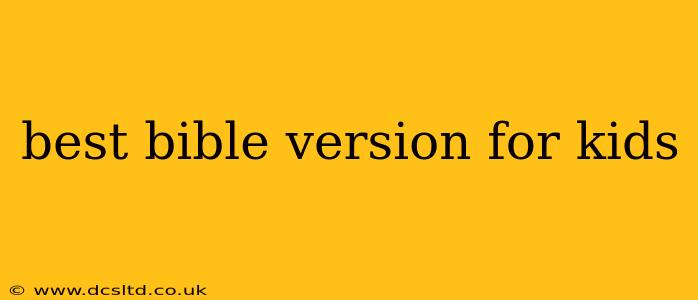Choosing the right Bible for your child can feel overwhelming. With so many versions available, it's crucial to select one that's engaging, easy to understand, and age-appropriate. This guide will help you navigate the options and find the perfect fit for your child's reading level and spiritual development. We'll explore different versions, highlight their strengths, and address common parental concerns.
What Makes a Kid-Friendly Bible?
Before diving into specific versions, let's establish what makes a children's Bible effective. Key characteristics include:
- Simple Language: Avoids complex vocabulary and theological jargon.
- Engaging Storytelling: Uses vivid language and captivating narratives to hold a child's attention.
- Age-Appropriate Content: Selects passages and presents information suitable for the child's maturity level.
- Visually Appealing: Includes illustrations, maps, or other visuals to enhance comprehension and engagement.
- Thematic Organization: Some Bibles group stories thematically, making it easier for kids to grasp overarching concepts.
Popular Children's Bible Versions and Their Strengths
Several excellent Bible versions cater specifically to children. Here are a few standouts:
-
The Beginner's Bible: This version is incredibly popular due to its simple language, large print, and vibrant illustrations. It focuses on retelling the stories in a way that's easily grasped by young children, often simplifying complex narratives.
-
The Jesus Storybook Bible: This version cleverly weaves together all of scripture's stories to tell the overarching story of God's love culminating in Jesus. It's beautifully illustrated and helps children see the connections between Old and New Testament stories.
-
NIV Adventure Bible for Kids: Based on the popular New International Version (NIV), this edition features engaging sidebars, maps, and illustrations that bring the Bible stories to life. It's suitable for slightly older children who are ready for a more detailed account of biblical events.
-
The Story Bible: Similar to "The Beginner's Bible," this version retells biblical stories in a clear and concise manner, making it easily accessible to young readers. It typically features colorful illustrations that help to keep children engaged.
What About Different Translations and Their Differences?
You might encounter terms like NIV, KJV, ESV, etc. These are different translations of the original biblical texts. For children, the key is readability and understanding, not strict adherence to a particular translation philosophy. Focus on versions designed for kids, regardless of the underlying translation.
H2: What age is my child ready for a Bible?
There's no single right answer; it depends on your child's reading level and maturity. Some children might engage with picture Bibles as young as 3, while others might prefer chapter books at age 8 or 9. Start with picture books or simplified versions and gradually introduce more complex texts as their comprehension improves.
H2: Should I choose a paraphrase or a literal translation?
For children, paraphrased versions (like those mentioned above) are generally preferred. They prioritize clarity and easy understanding over a word-for-word translation. Literal translations are often better suited for older children or adults who are ready for a more in-depth study of the text.
H2: What features should I look for in a children's Bible?
Look for clear, simple language, vibrant illustrations, age-appropriate content, and engaging storytelling. Maps, timelines, and extra features like character profiles can also enhance the learning experience.
Ultimately, the best Bible version for your child is the one that captures their attention, helps them understand the stories, and inspires their faith. Take the time to browse different versions, read sample passages, and choose the one that feels like the best fit for your family. Remember to make Bible reading a shared experience, discussing the stories and their meaning together.
